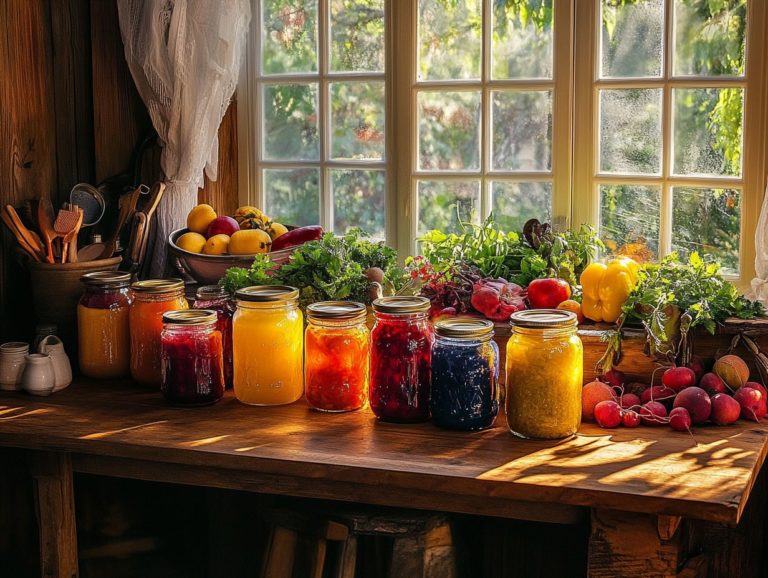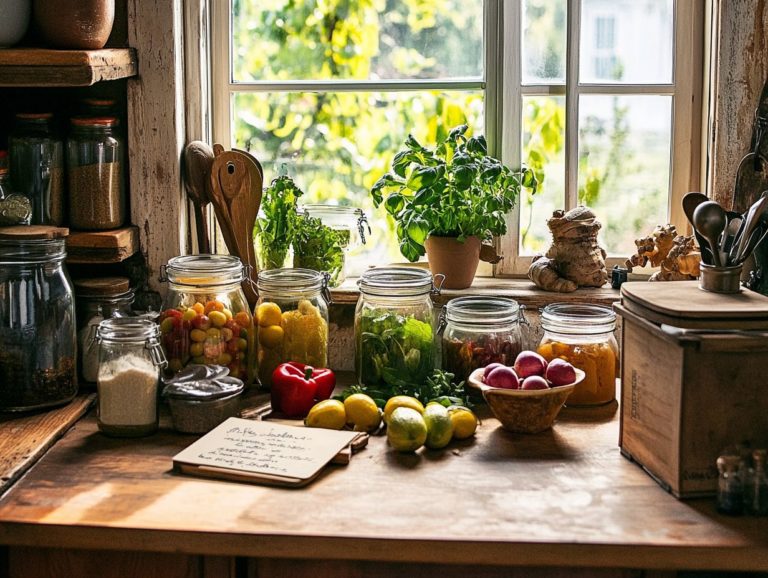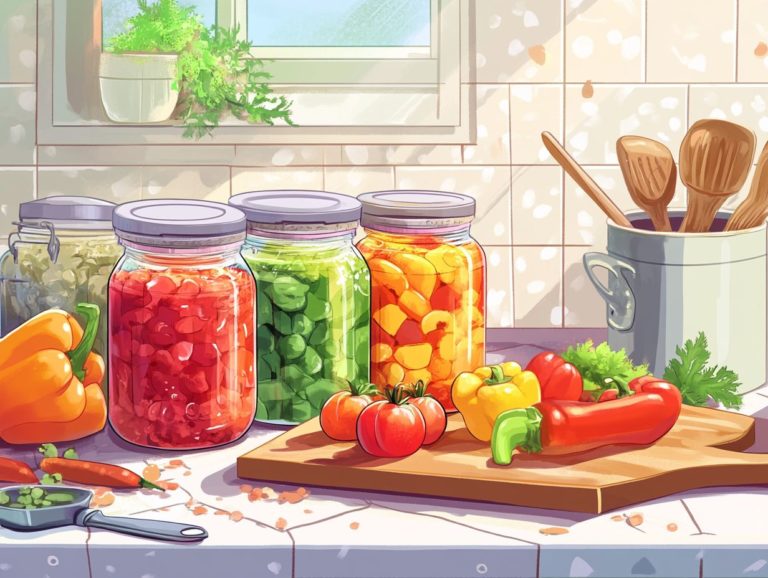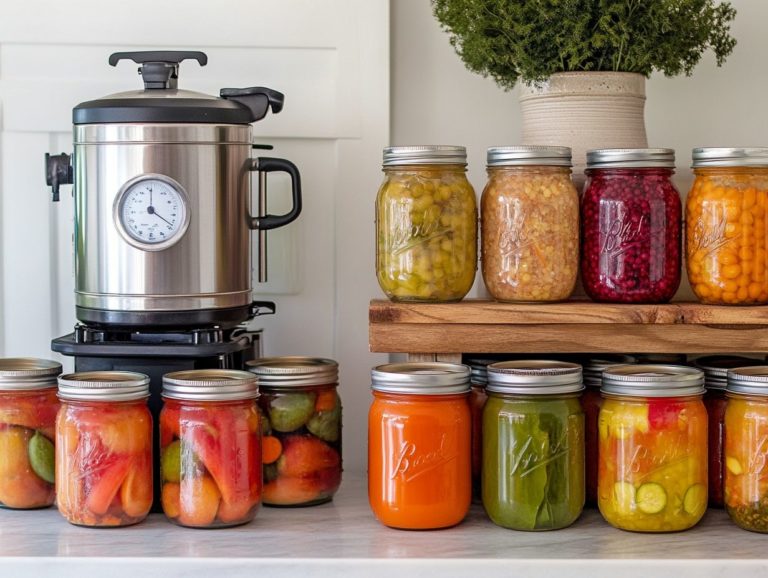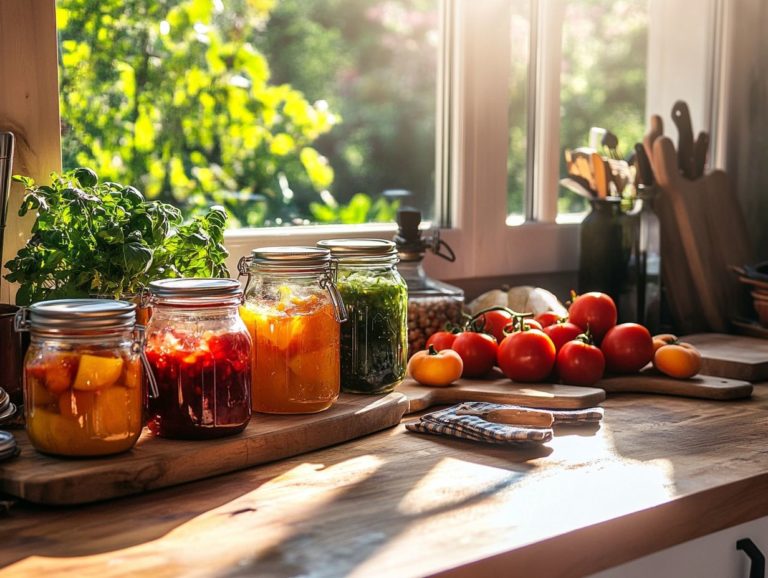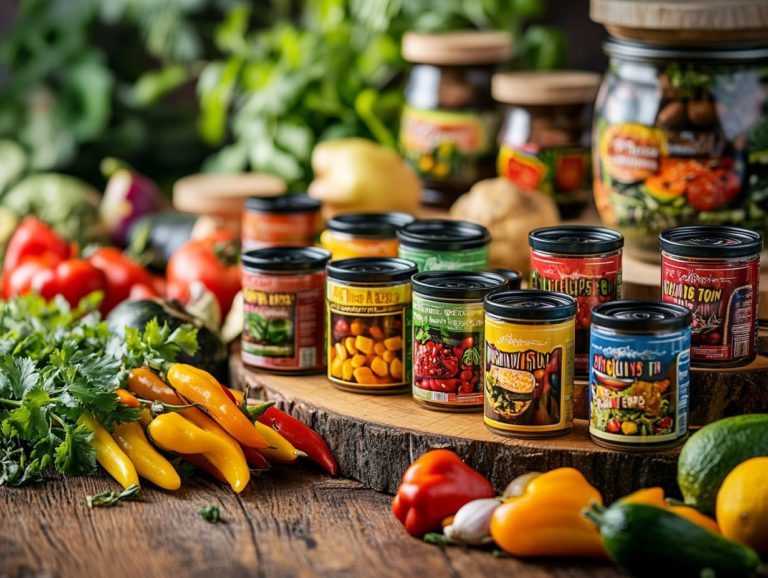How to Make the Most of Your Canning Season
As canning season approaches, it s the perfect moment for you to embrace the abundance of your garden or the delightful offerings from your local farmers’ market.
Whether you re a seasoned pro or just dipping your toes into the world of canning, this guide is designed to lead you through everything you need to know about preserving your favorite fruits and vegetables.
From gathering essential supplies to selecting the ideal foods and mastering the art of canning techniques, you ll discover it all right here.
You ll also uncover storage tips and inventive ways to enjoy your canned creations, along with troubleshooting advice to ensure your endeavors yield success.
Prepare yourself to relish the flavors of the season long after it has passed!
Contents
Key Takeaways:
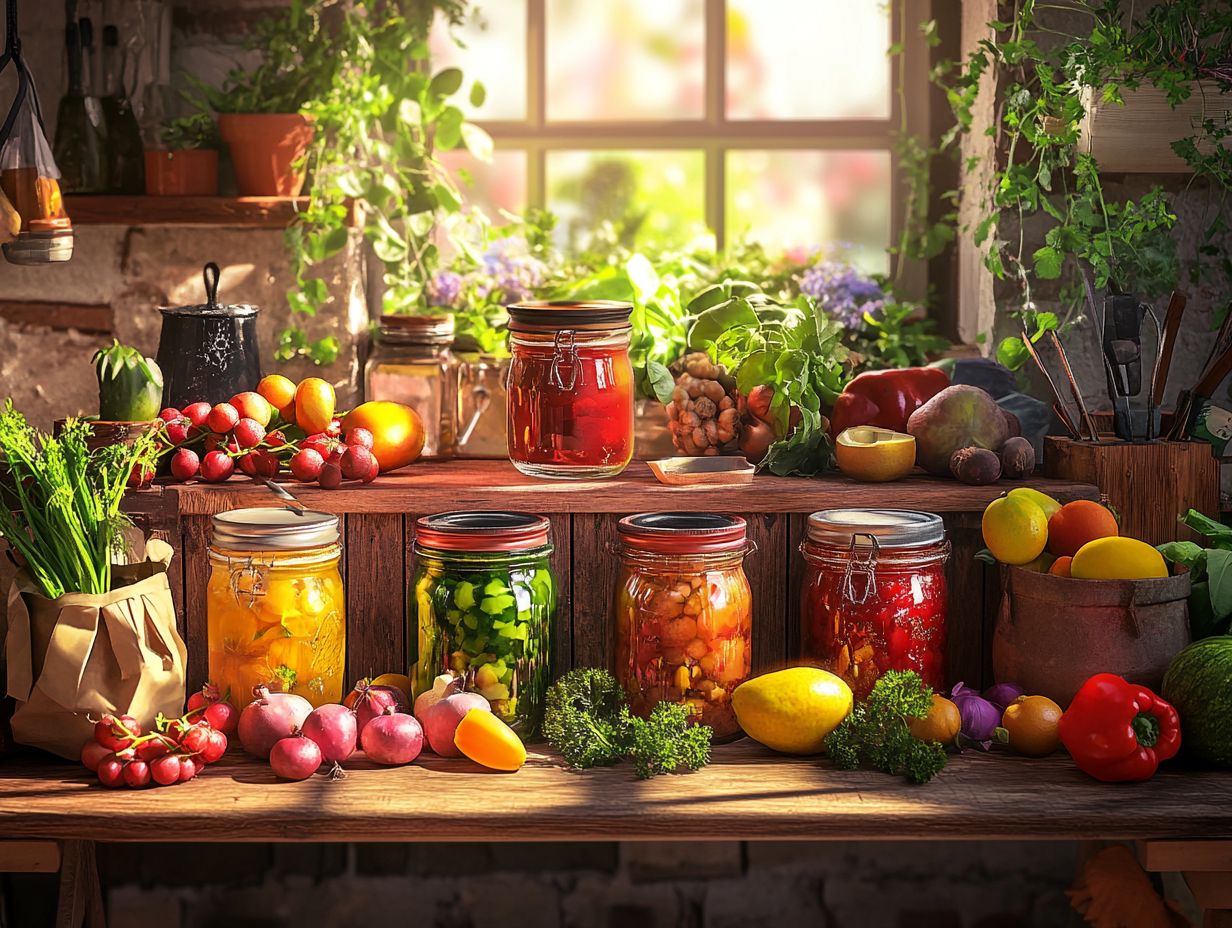
- Stock up on supplies and plan ahead to make the most of your canning season.
- Choose fresh, in-season produce and follow best practices for canning success.
- Explore different canning methods and learn proper storage techniques for your canned goods.
Preparing for Canning Season
As the preservation season draws near and cherry blossoms start to bloom, don’t miss out! Gather all your canning supplies now and check out this guide on how to organize your canning kitchen for an amazing season ahead.
Ensure you have all the necessary supplies at hand to craft your favorite homemade recipes, whether that s rich bone broth, hearty beef stew, or the crunchiest pickles.
This thoughtful preparation not only streamlines the canning process but also elevates the quality of your preserved goods. For more insights, check out these tips for canning with the whole family, allowing you to savor farm-fresh flavors all year round.
Gathering Supplies and Ingredients
Gathering the right canning supplies is essential for a successful canning season. Equip yourself with the proper tools, like canning jars, canning lids, a stainless steel funnel, and a bubble remover.
These tools streamline your canning process and safeguard the quality and safety of your preserved foods. When selecting canning jars, opt for brands specifically designed for canning; they re made from thicker glass that can endure high processing temperatures. Choose lids that create a proper seal to prevent spoilage. A stainless steel funnel will help keep spills at bay, while a bubble remover ensures efficient air removal for a tight seal.
Be sure to label your jars clearly with a black sharpie marker. Consider adding pasteurized apple cider vinegar to your recipes. It enhances flavors and plays a vital role in the preservation process. You might also explore options like Pamona s pectin or Cornaby s Thick Gel for your canning needs.
Planning for Success
Planning for success during the preservation season means crafting a strategy that includes a thorough inventory of supplies and understanding the differences between pressure canning (a method that uses high pressure to preserve low-acid foods) and water bath canning.
By developing a detailed list of necessary supplies and ingredients ahead of time, you can ensure a smooth workflow. This proactive approach saves you time and minimizes waste, allowing for the efficient use of seasonal produce.
Grasping the nuances between methods like the high temperatures achieved through pressure canning versus the straightforward nature of water bath canning can significantly enhance the quality and safety of your preserved items. You can also freeze-dry surplus produce. This technique extends shelf life while preserving essential nutrients.
Careful planning is vital for achieving efficient and successful canning, including knowing how to plan your canning schedule, culminating in a well-stocked pantry that you can enjoy long after the growing season has come to a close.
Choosing the Right Foods for Canning
Selecting the right foods for canning is a crucial step in your cooking experience. By choosing fruits and vegetables that are in season—think tomatoes, apples, strawberries, and blueberries—you elevate the flavor and quality of your preserved goods. Additionally, consider these tips for canning in warm weather to ensure the best results.
This thoughtful selection enhances taste and ensures that your food preservation efforts are successful, allowing you to savor the bounty of each season throughout the year.
Get ready to fill your pantry with delicious homemade preserves! Start canning today!
Fruits and Vegetables in Season
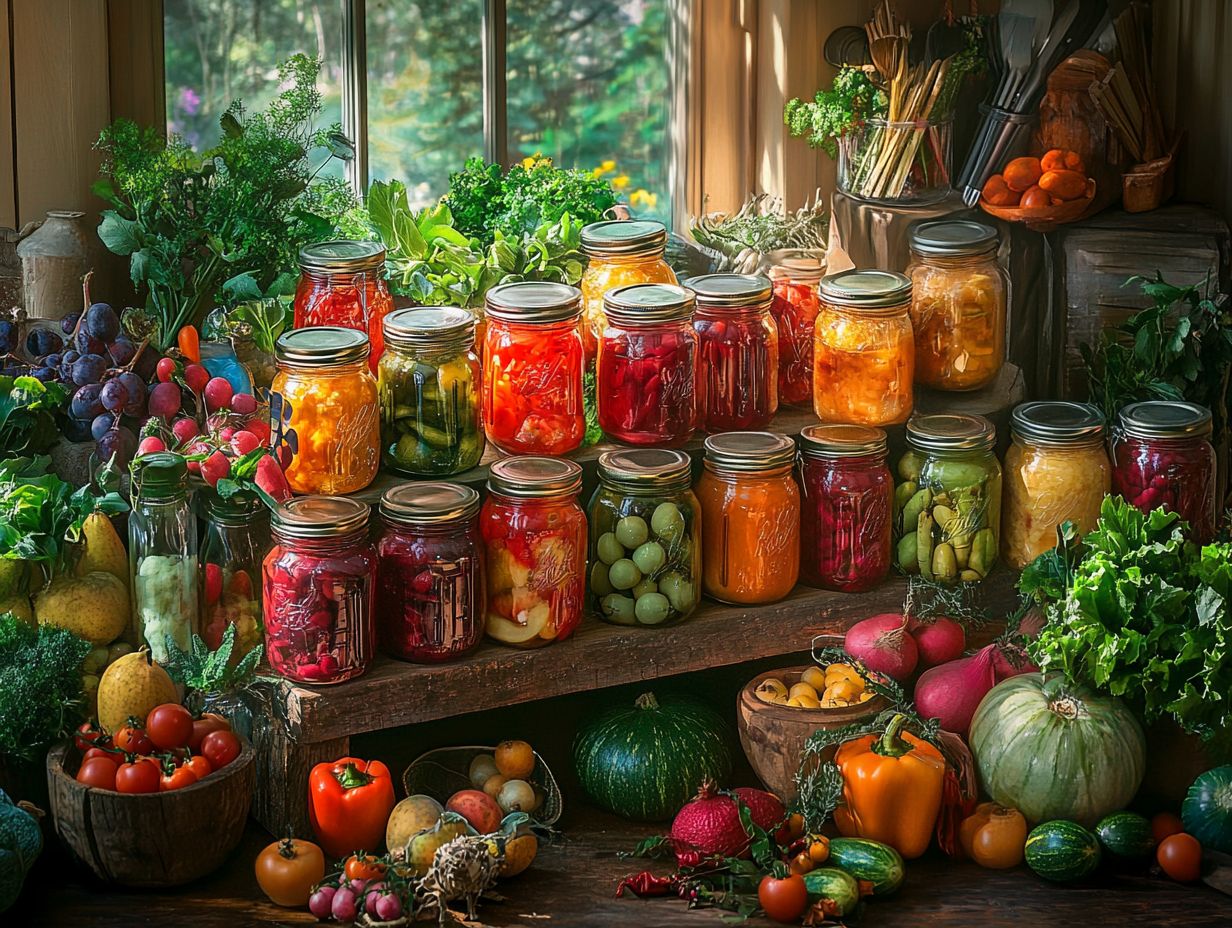
Utilizing fruits and vegetables that are in season is a key strategy for your successful canning endeavors. To learn more about when to can, check out is there a canning season? Seasonal produce like tomatoes, apples, strawberries, and blueberries not only tastes better but also boasts better preservation.
When you choose to can with seasonal fruits and vegetables, you are elevating flavor while embracing the peak of freshness. This results in a more vibrant end product. For example, late summer is the perfect time for canning tomatoes, celebrated for their rich flavor. Additionally, the best times of year for canning include autumn, which presents a bounty of apples that are ideal for sweet preserves.
Sourcing these ingredients from local farmers’ markets or community-supported agriculture (CSA) programs guarantees you’re securing the freshest, most flavorful produce available. Timing is essential not just for flavor but also for maximizing the nutrients locked within these fruits and vegetables, ensuring your canned goods are both delicious and wholesome.
Best Practices for Canning Different Foods
Implementing best practices for canning various foods is essential to ensure the safety and quality of your preserved goods, especially when working with popular ingredients like tomatoes, apples, strawberries, and blueberries.
By adhering to proven safety guidelines, you not only protect yourself and others from foodborne illnesses but also enhance the flavor and nutritional value of the canned items. Each type of produce may require specific processing times and methods. For instance, foods with less acidity often need pressure canning, while foods with more acidity can thrive with water bath canning.
Take tomatoes, for example they benefit greatly from a straightforward boiling water bath. Meanwhile, an apple preserves recipe might involve a delightful combination of steaming and sugar to enhance sweetness. By following these practices carefully, you can significantly influence the taste, texture, and shelf life of your end product.
It’s crucial to rely on a trustworthy guide, like those from Merissa or on platforms such as Amazon or Lehman s, while canning to achieve the best results.
Methods of Canning
Grasping the various methods of canning is essential for effective food preservation. Both water bath canning and pressure canning present distinct advantages that cater to different food types and your desired outcomes in the canning process.
Water Bath Canning
Water bath canning is a highly regarded method for preserving high-acid foods, such as fruits and pickled vegetables, making it a critical technique in the realm of food preservation.
To master this method, you ll need to gather specific equipment:
- Large pot
- Canning jars with lids
- Jar lifter
- Funnel
Begin by washing the jars and lids thoroughly, then prepare your ingredients. Opt for fruits like peaches, berries, or tomatoes, along with pickles, as their acidity is perfect for this process. Maintaining the necessary acidity levels is crucial to prevent bacterial growth, so don t hesitate to add lemon juice or vinegar if needed.
As you fill the jars, remember to leave about a half-inch of headspace for proper sealing. Then, process them in boiling water for the recommended time according to your recipe. Consider using Mylar bags for long-term storage to maintain freshness. By adhering to these guidelines, you can achieve results that are both safe and delicious!
Start your canning adventure today and savor the flavors of the season!
Pressure Canning
Get ready to dive into the exciting world of canning! Pressure canning is an essential method for safely preserving low-acid foods like vegetables and meats. It plays a crucial role in ensuring food safety throughout the process.
This technique requires specialized equipment, specifically a pressure canner. This special pot creates high pressure and operates at high temperatures to effectively eliminate harmful bacteria, spores, and pathogens that thrive in low-acid environments.
As you embark on this canning journey, gather all the necessary tools: jars, lids, and a jar lifter. Don’t forget to follow important safety precautions like checking seals and keeping your workspace pristine.
The step-by-step process starts with preparing your food and filling the jars just right. Next, process them in the canner according to established time guidelines.
Mastering pressure canning not only guarantees food quality but also significantly reduces the risk of foodborne illnesses. This makes it an invaluable skill for any home preservation enthusiast.
Storing and Using Canned Goods
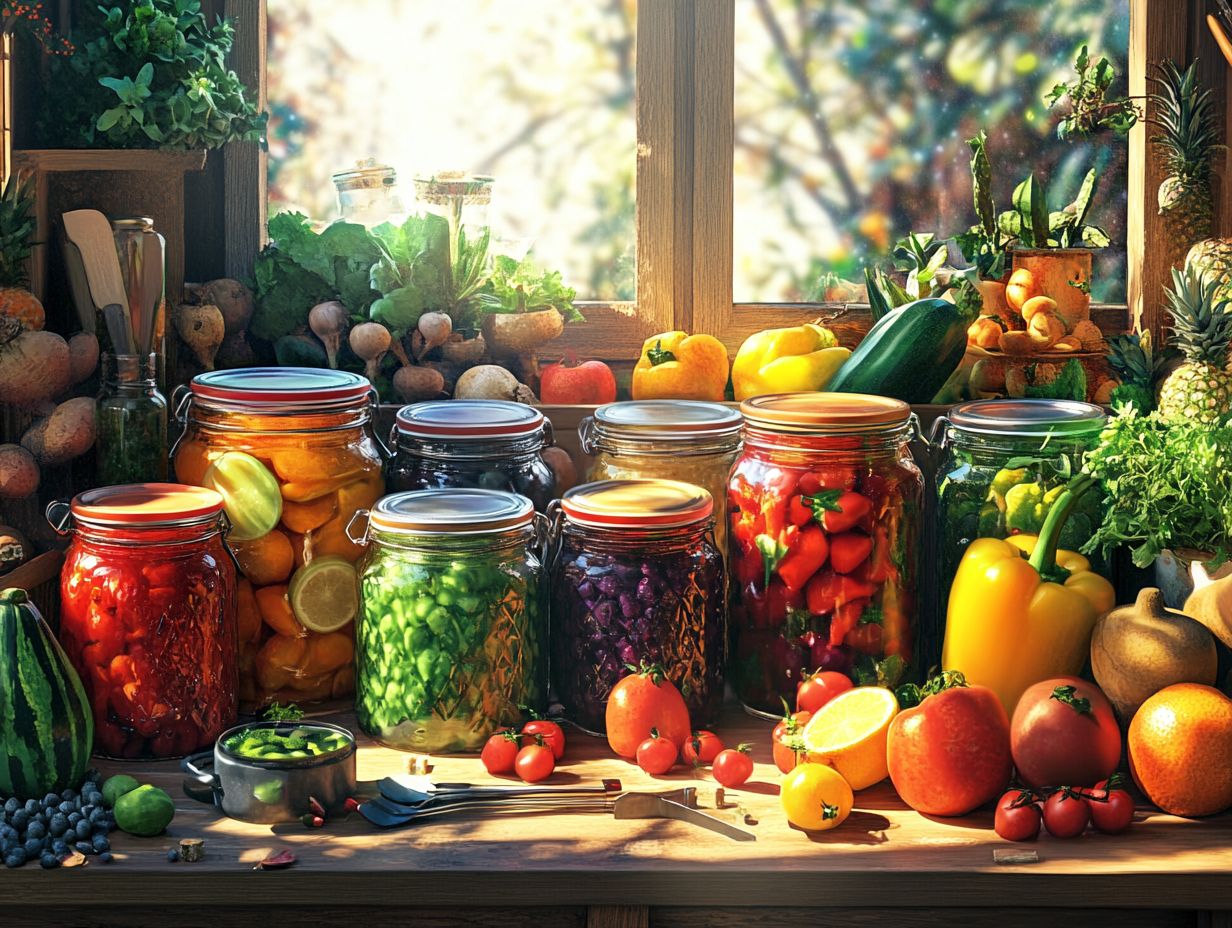
Properly storing and using canned goods is essential for maximizing both their shelf life and flavor. By mastering effective food preservation techniques like freeze dryer oil to maintain your Harvest Right freeze dryer you can truly elevate your experience and savor your homemade creations all year long.
Proper Storage Techniques
Implementing proper storage techniques for your canned goods is vital for ensuring their longevity and safety. Factors like temperature, light exposure, and organization significantly affect food preservation.
Maintaining a stable, cool environment is critical. Excessive heat can spoil the contents and diminish their quality. Store your canned goods in a temperature-controlled area, far from direct sunlight and humidity.
Dark storage spaces shield your cans from light, protecting nutrients and preserving flavor. They also enhance the overall lifespan of your products. Effective organization methods like labeling and rotating older items to the front can streamline access and ensure that nothing slips through the cracks.
By following these best practices, you can extend the shelf life and flavor integrity of your canned goods, ensuring they remain as delightful as the day you bought them.
Creative Ways to Use Canned Foods
Discovering fun ways to use canned foods can lead to delicious meals and snacks. Transform your home-preserved goods into culinary delights that celebrate the flavors of your favorite ingredients.
Imagine zesty bean salads that burst with freshness or hearty soups enriched with canned tomatoes and vegetables the possibilities are endless! Canned foods provide a fantastic foundation, inviting an array of spices and herbs to elevate your dishes.
You might blend canned fruits into smoothies or desserts for a nutritious twist, or craft savory casseroles layered with canned proteins for a quick and satisfying dinner solution.
By embracing a bit of experimentation, these versatile pantry staples save you time, minimize food waste, and give you the power to showcase your creativity and personal taste in the kitchen.
Troubleshooting Common Canning Issues
Troubleshooting common canning issues is an invaluable skill for you as a home canner. By mastering the art of preventing spoilage and contamination, you can greatly elevate the quality and safety of your preserved foods. This ensures that every jar reflects your dedication to excellence.
Preventing Spoilage and Contamination
Preventing spoilage and contamination is crucial in the canning process. By adhering to safety guidelines and employing proper techniques, you can ensure the longevity and safety of your food preservation efforts.
This involves several critical practices that every canner should know to achieve the best results. One key step is thoroughly sterilizing jars and lids before use. Any lingering bacteria can jeopardize the entire batch. Ensuring a proper seal on each jar locks in freshness and protects against potential leaks and spoilage.
Regularly checking storage conditions, such as temperature and humidity, is essential for maintaining the integrity of your preserved goods. Following established canning guidelines closely helps you navigate the risks associated with food preservation effectively and ensures peace of mind in your culinary endeavors.
Fixing Common Problems
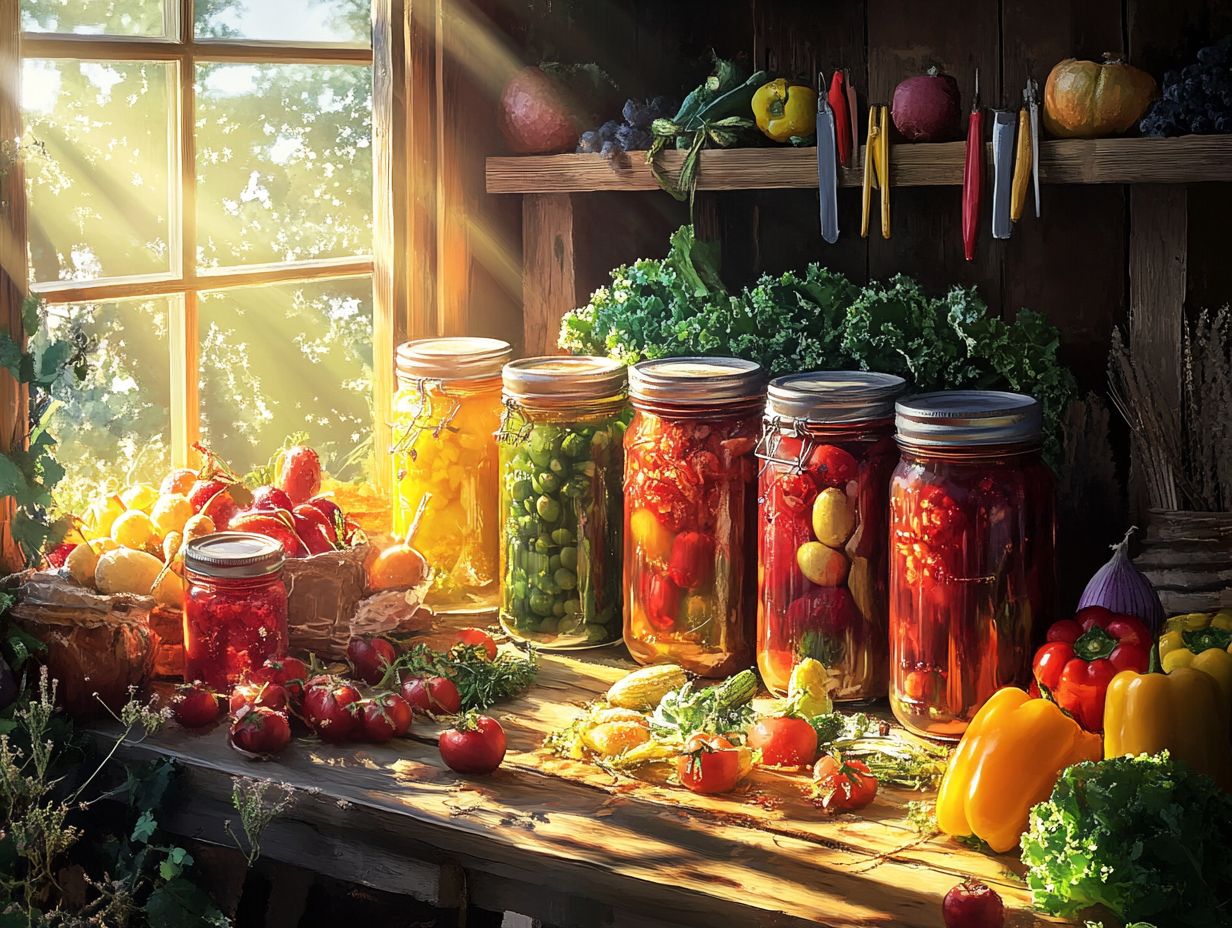
Fixing common problems in the canning process like air bubbles, improper seals, and food discoloration requires a good grasp of troubleshooting techniques to guarantee your food preservation efforts yield success.
By recognizing these issues early on, you can take proactive steps to enhance the outcomes of each canning session. For instance, ensuring there are no air bubbles during the filling process strengthens seal integrity. Carefully inspecting jars before use helps you avoid the pitfalls of improper seals.
Using ascorbic acid or lemon juice works wonders against food discoloration, ensuring your preserved items boast vibrant colors. Educating yourself on these solutions boosts your confidence and transforms the canning experience into something truly rewarding. You can effectively turn your fruits and vegetables into delightful, long-lasting preserves.
Frequently Asked Questions
Here are some common questions about canning:
What is canning season?
Canning season is typically the time of year when fruits and vegetables are at their peak and harvested in abundance. Understanding the impact of seasonal produce on canning makes it the perfect time to preserve them for later use.
When is the best time to start canning season?
The best time to start canning season varies depending on your location and the specific fruits and vegetables you want to preserve. To get the most out of your efforts, consider these top canning tips from experts, which generally recommend starting when produce is at its freshest and most abundant.
What are some tips for making the most of canning season?
- Plan ahead and make a list of the fruits and vegetables you want to preserve.
- Stock up on necessary canning supplies such as jars, lids, and labels.
- Take advantage of sales and bulk discounts for produce.
- Involve friends and family in the process for a fun and efficient experience.
- Try new recipes and experiment with different flavor combinations.
Can I use any type of jar for canning?
No, it is important to use jars specifically designed for canning to ensure proper sealing and safety. Mason jars and Ball jars are popular options.
How do I know if my jars are properly sealed?
You can check for proper sealing by pressing down on the center of the lid. If it does not pop back up, the jar is sealed. You can also lift the jar by the lid to ensure it is securely sealed.
How long can I store canned goods?
Properly sealed and stored canned goods can last up to 1 year. However, it is recommended to use them within 6-8 months for optimal flavor and quality.
Don’t miss out on preserving your harvest! Start your canning journey today by following the do’s and don’ts of canning and enjoy delicious preserves all year long!

